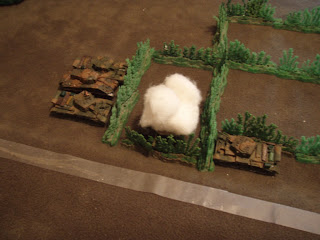
Maharajah 2008 1st Semi Final Free For All
Steve's Panzer Lehr
HQ 2 Panther
375
Bergepanther
15
4 Panthers
750
4 Jagdpanzer IV
 380
380
Whitman
350
3 Flakpanzer 38t
120
1990
Jim's 7th Armoured
HQ 2Crom+2AA+Arve
260
3 Crom + 1 Firefly
325
3 Crom + 1 Firefly
325
 3 Crom + 1 Firefly
3 Crom + 1 Firefly
325
Field Batt SP (8 Sextons)
355
Rifles
135
4 M10
275
2000
Both sides were pretty unimpressed with the terrain Nick had provided for them. While there was a good deal of welcome concealment in the form of low hedges & cornfields, rivers & streams cut of corners & a road embankment ran almost down the middle between the two armies making attacking a dangerous option (bogging roll to cross).
The Germans got the first move but held back defending the wood with the British RH objective with Flakpanzers inside & Jagdpanzers on the edge, Panthers on the left and right of it, & Whitman in ambush.
The Brits deployed their mass of armour in a long line, weighted to the right with the M10s in the centre. The Sextons were in a conrfield in the rear while the infantry were in the centre cornfield. The infantry snuck forward in the cornfields while the armour was carefully positioned behind the embankment & the Sextons did a bit of long range sniping - getting first blood by popping a Panther.
With both sides at long range and firing at veteran concealed targets across embankments, hedges, woods & cornfields it was all about sixes. The Brits immediately got the best of it picking on the Jagdpanzers in the wood & popping 2 for no loss.
Whitman came out of ambush in a hedge on the German lright. He had 3 shots with re-rolls & 5's to hit the Cromwells - and missed the lot. The Panthers came forward centre & (German) left but also missed before stormtropping back out of range.
The Sextons dropped smoke to screen off Panthers on each flank, the M10s moved up & fired at the command platoon - 4 dice, 4 rats & a dead CIC. On the right the LH Cromwell platoon charged over the embankment, passed all bogging rolls & took 4 side shots at Whitman's Tiger. The Firefly & first 2 Cromwells missed, but the 4th hit, Steve rolled a 1 & Whitman died. With that double whammy the German morale cracked & they conceded the battle.
The Germans had lost their CiC, their Hero & half their armour without even getting a hit on the Brits. While the Brits might claim to have used some pretty good tactics, it has to be admitted that for once the Red Rats trunped the famous black L's. A good plan backed by hot dice is a pretty mean combination - it was all over in less than an hour.
Steve's Panzer Lehr
HQ 2 Panther
375
Bergepanther
15
4 Panthers
750
4 Jagdpanzer IV
 380
380Whitman
350
3 Flakpanzer 38t
120
1990
Jim's 7th Armoured
HQ 2Crom+2AA+Arve
260
3 Crom + 1 Firefly
325
3 Crom + 1 Firefly
325
 3 Crom + 1 Firefly
3 Crom + 1 Firefly325
Field Batt SP (8 Sextons)
355
Rifles
135
4 M10
275
2000
Both sides were pretty unimpressed with the terrain Nick had provided for them. While there was a good deal of welcome concealment in the form of low hedges & cornfields, rivers & streams cut of corners & a road embankment ran almost down the middle between the two armies making attacking a dangerous option (bogging roll to cross).
The Germans got the first move but held back defending the wood with the British RH objective with Flakpanzers inside & Jagdpanzers on the edge, Panthers on the left and right of it, & Whitman in ambush.
The Brits deployed their mass of armour in a long line, weighted to the right with the M10s in the centre. The Sextons were in a conrfield in the rear while the infantry were in the centre cornfield. The infantry snuck forward in the cornfields while the armour was carefully positioned behind the embankment & the Sextons did a bit of long range sniping - getting first blood by popping a Panther.
With both sides at long range and firing at veteran concealed targets across embankments, hedges, woods & cornfields it was all about sixes. The Brits immediately got the best of it picking on the Jagdpanzers in the wood & popping 2 for no loss.
Whitman came out of ambush in a hedge on the German lright. He had 3 shots with re-rolls & 5's to hit the Cromwells - and missed the lot. The Panthers came forward centre & (German) left but also missed before stormtropping back out of range.
The Sextons dropped smoke to screen off Panthers on each flank, the M10s moved up & fired at the command platoon - 4 dice, 4 rats & a dead CIC. On the right the LH Cromwell platoon charged over the embankment, passed all bogging rolls & took 4 side shots at Whitman's Tiger. The Firefly & first 2 Cromwells missed, but the 4th hit, Steve rolled a 1 & Whitman died. With that double whammy the German morale cracked & they conceded the battle.
The Germans had lost their CiC, their Hero & half their armour without even getting a hit on the Brits. While the Brits might claim to have used some pretty good tactics, it has to be admitted that for once the Red Rats trunped the famous black L's. A good plan backed by hot dice is a pretty mean combination - it was all over in less than an hour.
Pic 1: Deployment - from behind British left.
Pic 2: Panzers burning everywhere - from behind British left.
Pic 3: Whitman's Tiger burns.








